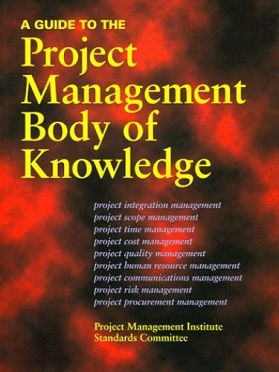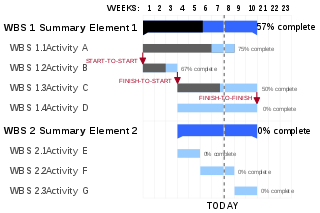Project management is the process of leading the work of a team to achieve all project goals within the given constraints. This information is usually described in project documentation, created at the beginning of the development process. The primary constraints are scope, time, and budget. The secondary challenge is to optimize the allocation of necessary inputs and apply them to meet pre-defined objectives.

Risk management is the identification, evaluation, and prioritization of risks followed by coordinated and economical application of resources to minimize, monitor, and control the probability or impact of unfortunate events or to maximize the realization of opportunities.

Safety engineering is an engineering discipline which assures that engineered systems provide acceptable levels of safety. It is strongly related to industrial engineering/systems engineering, and the subset system safety engineering. Safety engineering assures that a life-critical system behaves as needed, even when components fail.
A project plan, according to the Project Management Body of Knowledge (PMBOK), is: "...a formal, approved document used to guide both project execution and project control. The primary uses of the project plan are to document planning assumptions and decisions, facilitate communication among project stakeholders, and document approved scope, cost, and schedule baselines. A project plan may be sumarized or detailed."

The Project Management Body of Knowledge (PMBOK) is a set of standard terminology and guidelines for project management. The body of knowledge evolves over time and is presented in A Guide to the Project Management Body of Knowledge, a book whose seventh edition was released in 2021. This document results from work overseen by the Project Management Institute (PMI), which offers the CAPM and PMP certifications.

A Gantt chart is a bar chart that illustrates a project schedule. It was designed and popularized by Henry Gantt around the years 1910–1915. Modern Gantt charts also show the dependency relationships between activities and the current schedule status.

PRINCE2 is a structured project management method and practitioner certification programme. PRINCE2 emphasises dividing projects into manageable and controllable stages.
Information technology (IT)governance is a subset discipline of corporate governance, focused on information technology (IT) and its performance and risk management. The interest in IT governance is due to the ongoing need within organizations to focus value creation efforts on an organization's strategic objectives and to better manage the performance of those responsible for creating this value in the best interest of all stakeholders. It has evolved from The Principles of Scientific Management, Total Quality Management and ISO 9001 Quality management system.
A risk management plan is a document that a project manager prepares to foresee risks, estimate impacts, and define responses to risks. It also contains a risk assessment matrix. According to the Project Management Institute, a risk management plan is a "component of the project, program, or portfolio management plan that describes how risk management activities will be structured and performed".
Project Management Professional (PMP) is an internationally recognized professional designation offered by the Project Management Institute (PMI). As of 31 July 2020, there are 1,036,368 active PMP-certified individuals and 314 chartered chapters across 214 countries and territories worldwide.
Adaptive software development (ASD) is a software development process that grew out of the work by Jim Highsmith and Sam Bayer on rapid application development (RAD). It embodies the principle that continuous adaptation of the process to the work at hand is the normal state of affairs.

Event chain methodology is a network analysis technique that is focused on identifying and managing events and relationship between them that affect project schedules. It is an uncertainty modeling schedule technique. Event chain methodology is an extension of quantitative project risk analysis with Monte Carlo simulations. It is the next advance beyond critical path method and critical chain project management. Event chain methodology tries to mitigate the effect of motivational and cognitive biases in estimating and scheduling. It improves accuracy of risk assessment and helps to generate more realistic risk adjusted project schedules.
MEHARI is a free, open-source information risk analysis assessment and risk management method, for the use of information security professionals.
ISO/IEC 27005 "Information technology — Security techniques — Information security risk management" is an international standard published by the International Organization for Standardization (ISO) and the International Electrotechnical Commission (IEC) providing good practice guidance on managing risks to information. It is a core part of the ISO/IEC 27000-series of standards, commonly known as ISO27k.
A glossary of terms relating to project management and consulting.

In simple terms, risk is the possibility of something bad happening. Risk involves uncertainty about the effects/implications of an activity with respect to something that humans value, often focusing on negative, undesirable consequences. Many different definitions have been proposed. The international standard definition of risk for common understanding in different applications is "effect of uncertainty on objectives".
Risk management tools allow the uncertainty to be addressed by identifying and generating metrics, parameterizing, prioritizing, and developing responses, and tracking risk. These activities may be difficult to track without tools and techniques, documentation and information systems.

IT risk management is the application of risk management methods to information technology in order to manage IT risk, i.e.:
Within project management, risk management refers to activities for minimizing project risks, and thereby ensuring that a project is completed within time and budget, as well as fulfilling its goals.
ISO 22300:2021, Security and resilience – Vocabulary, is an international standard developed by ISO/TC 292 Security and resilience. This document defines terms used in security and resilience standards and includes 360 terms and definitions. This edition was published in the beginning of 2021 and replaces the second edition from 2018.







